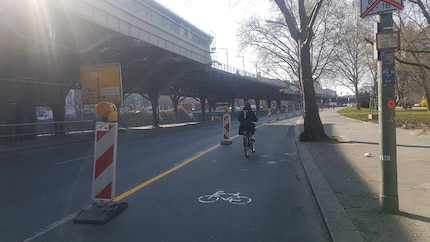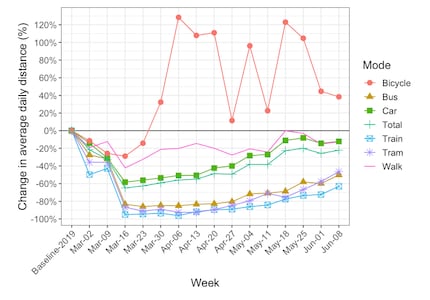
Background information
Pilot project in the Netherlands: forced braking for electric bikes
by Michael Restin

All over the world, improvised cycle paths are springing up like mushrooms. Cycling enthusiasts can take to the roads and enjoy the fresh morning air. But what about Switzerland? Is the wheel turning for us too?
Imagine a world faced with a gigantic environmental problem, global warming that would threaten the survival of humanity! The arteries of the metropolises would be tangled with vehicles occupied by people on the verge of heart attacks because of overweight and sedentary lifestyles, direct consequences of prosperity. And then there would be a global pandemic that would paralyse everyday life and force us to rethink everything.
Wouldn't this be the perfect opportunity to finally tackle the problems in a radical way? From this point of view, and only from this point of view, this scenario seems almost too good to be true.
But it is reality.
Cities around the world are seizing the opportunity emanating from this crisis by freeing up space for cyclists, quickly and without red tape, in particular through cycle lanes and strips and makeshift parking areas, allowing distance and safe use. Bogotá, the capital of Colombia, has freed up more than 100 kilometres for bicycle traffic. Mexico City, Vancouver, Milan, Berlin and Paris are following this path of goodwill.

London Mayor Sadiq Khan isn't shying away from major intervention in the city's arterial roads, and Prime Minister Boris Johnson is talking of a "new golden age" for cyclists that could click into gear. At a time when people are avoiding public transport because of the risk of infection, a kind of final battle for individual transport is looming on the horizon. Whether cars or bikes win depends on the reactions of local authorities.
In her latest report, Rachel Alred, Professor of Active Mobility at Westminster University, estimates that daily "tin runs" in England and Wales could swell commuting by more than a million. If cycling does not establish itself now as the attractive alternative, this negative scenario will occur. In the future, the infrastructure we are talking about could mean that short distances of less than ten kilometres are covered millions of times more frequently on foot or by bike. As a result, the government is providing £225 million for appropriate measures designed to relieve congestion on the roads, while also having a positive effect on health. The report suggests that 500 premature deaths a year could be avoided by changing travel habits alone. In addition, being overweight is considered a major risk factor for COVID-19 infections.
If the groundwork is laid in an innovative and correct way, then it would be possible to kill two birds with one stone. In this case, no future technology is needed, just an invention that is over 200 years old: the bicycle, enhanced by today's technology. Electric bicycles have reached maturity, are affordable and offer unrivalled efficiency in local traffic. The 55 kWh of a Tesla Model 3, with a range of around 400 km, could be used to travel 6,000 km at the very least if fitted with an EAB. Electric assistance has made cycling attractive to many users who had previously failed because of the topography of their environment. Thanks to the 500-watt motor, journeys to work have become quick and sweat-free. Cargo bikes can even carry bulky shopping bags. Finally, on the way to the nursery, bike trailers come in very handy. Electric bikes, which have long since shed their dusty image as a means of transport for pensioners, keep their users in as good health as non-motorised cyclists, provided they are not involved in an accident, which unfortunately happens generalising.
In recent months, the Swiss have been getting on their bikes more often if the MOBIS-COVID study: "Here we see a very sharp increase that goes well beyond the expected seasonal effects". During the period of confinement, bicycles were used mainly as fitness equipment. But on the road to the new normal, it should also play a more important role for us. So far, it has received little spontaneous support.

In the press-release concerning World Bike Day decreed on June 3, Pro Velo writes: "In Switzerland, only the Canton and City of Geneva have so far responded with a series of measures to encourage cycle traffic."The call to rebound on this opportunity to initiate radical changes remains largely ignored.
Some cities have long acted on the motto "bikes, lanes", which doesn't just apply to congested metropolises. Since 2017, the centre of Ghent, a Belgian city with a population of 260,000, has been car-free. Similarly, Brussels is venturing into "Vélorution" by declaring the inner ring road a priority for cyclists and pedestrians, who are authorised to move everywhere, on the pavement and the roadway. Cars, buses and trams are limited to 20 km/h. From 2021, the speed limit will be reduced to 30 km/h throughout the city.
Instead of starting a revolution or at least sending an immediately visible signal, the "policy of small steps" continues. Under the law on cycle lanes, the Cantons will in future have the obligation to plan cycle lanes and ensure that the network of cycle lanes is interconnected and safe.
It's all very well for the Cantons to take a step backwards.
That's all well and good, but it remains a utopian vision, while elsewhere extra-wide cycle lanes are springing up spontaneously and showing what the future could be like. Our mobility behaviour is changing. To encourage people to adopt cycling in the long term, they need to be convinced that a cycle path can be more than a narrow survival strip at the side of the road. Otherwise, the time window will close and car traffic will continue to increase. For once, I'd like Boris Johnson to be right, for the coronavirus crisis to give way to a golden age of cycling.
Simple writer and dad of two who likes to be on the move, wading through everyday family life. Juggling several balls, I'll occasionally drop one. It could be a ball, or a remark. Or both.
Interesting facts about products, behind-the-scenes looks at manufacturers and deep-dives on interesting people.
Show all